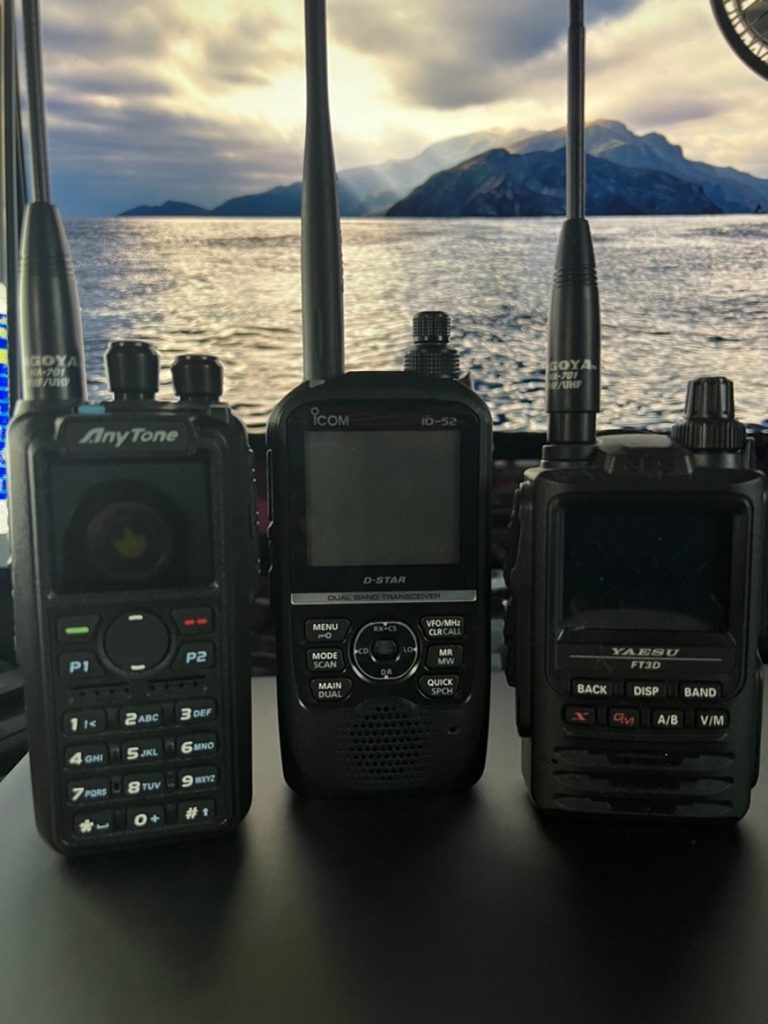As I explained in Part 1 of this series, I love handy talkies (HTs). If there is a 12-step program for this addiction, I better be enrolled. Let’s continue the discussion in my four-part series by getting into digital radios and the influx of inexpensive HTs on the market.
First, what exactly is digital radio? The previous old-school radios we discussed were all analog. Digital radio encodes speech into a data stream before transmitting. Some types of digital include:
- APCO P25: Found in repurposed public safety equipment from multiple vendors. Uses IMBE or AMBE CODEC over FSK.
- D-STAR: Open specification with proprietary vocoder system available from Icom, Kenwood, and FlexRadio systems. Uses AMBE over GMSK with VoIP capabilities.
- DMR: Found in both commercial and public safety equipment from multiple vendors. Uses AMBE CODEC over an FSK modulation variant with TDMA.
- System Fusion: Open specification with proprietary vocoder system available from Yaesu. Uses AMBE CODEC with C4FM modulation.
- FreeDV: Open Source Amateur Digital Voice. Uses LPCNet Quantiser CODEC with differential or coherent PSK.
- M17: Another open source digital voice mode based on CODEC 2. Uses 4FSK. Utilizes punctured convolutional coding and quadratic permutation polynomials for error control and bit stream re-ordering.
We will stick with the most popular three for ham radio: System Fusion, D-STAR, and DMR.

From its website, here’s what Yaesu says about System Fusion:
System Fusion is Yaesu’s implementation of Digital Amateur Radio, utilizing C4FM 4-level FSK Technology to transmit digital voice and data over the amateur radio bands. In the early 2000s, GMSK emerged in the amateur radio market as the dominant digital mode. However, in 2013, Yaesu introduced System Fusion, which quickly became the dominating digital format in amateur radio because of quality, reliability, and enhanced performance in a wide range of environments.
System Fusion belongs solely to Yaesu, which is both a pro and a con. Being a closed system makes it very stable; however, it also means if you want to use System Fusion, you need to own a Yaesu radio with that capability. No other choices exist.
Here’s how its Wikipedia page describes D-STAR:
D-STAR (Digital Smart Technologies for Amateur Radio) is a digital voice and data protocol specification for amateur radio. The system was developed in the late 1990s by the Japan Amateur Radio League and uses minimum-shift keying in its packet-based standard. There are other digital modes that have been adapted for use by amateurs, but D-STAR was the first that was designed specifically for amateur radio.
D-STAR is considered an open system, but not everything is completely open. Voice is converted to a digital format using a bit of computer code referred to as a CODEC. The CODEC code is embedded on a microchip which encodes and decodes the audio signals into and out of the AMBE (Advanced Multi-Band Excitation format). The CODEC that D-STAR uses is the only proprietary portion of D-STAR. All other parts of D-STAR are open, which has allowed some platforms to develop this part of the hobby. It is seen mostly in Icom radios, but Kenwood and Flex have had the technology as well. None of these options are particularly easy on the wallet.
DMR is explained on the Motorola website:
DMR stands for Digital Mobile Radio and is an international standard that has been defined for two-way radios. The DMR standard allows equipment developed by different manufacturers to operate together on the same network for all the functions defined within the standard.
The aim of the DMR standard was to create a digital radio system with low complexity and low cost that still allows for equipment from different manufacturers to work together, allowing users to shop around rather than being locked into a proprietary system which would be costly to replace and maintain.
The European Telecommunications Standards Institute (ETSI) is responsible for the creation and maintenance of the DMR standard. The standard was first ratified in 2005 and has subsequently been updated and revised several times, most recently in November 2018.
DMR is different from the others as a TDMA mode (Time Division Multiple Access), which means that it allows several users to share the same frequency channel by dividing that signal into different time slots. Each frequency has a slot 1 or slot 2 and each slot can be used by different users. It is also different by being a completely open source. The primary goal of the standard is to specify a digital system with low complexity, low cost, and interoperability across brands, so radio communications purchasers are not locked into a proprietary solution.
Does this mean it also has low quality and stability? I will leave that determination up to you. DMR also seems to have brought about a rise in the evolution of many cheaply made HT brands and models.
So many models and options keep coming to the market. Many studies have been done showing these inexpensive brands’ performance isn’t as good, their materials are cheaper, and their quality is questionable, at best, so keep these limitations in mind when shopping for an HT based on cost alone. I don’t even want to get into what it takes to program these radios. They truly are disposable if anything goes wrong.
Questions? Have a fun digital to share? Share them in the comments below or email me at KE8FMJ@gmail.com.

